Beyond Trends: How to Sense the Underlying Currents in Art and Culture
Understanding the Essence of Art and Culture
Art and culture are dynamic entities, constantly evolving and reflecting the human experience. While trends are often the visible layer that captures public attention, there are deeper, more subtle currents that shape the creative landscape. These undercurrents are the soul of artistic expression and cultural development, offering insights into societal shifts and human psychology.
In a world dominated by fleeting trends, it becomes crucial to delve beyond the surface to understand the enduring elements that influence art and culture. Grasping these underlying currents not only enriches our appreciation but also enhances our ability to anticipate future movements.

The Role of Historical Context
Historical context plays a significant role in shaping the underlying currents of art and culture. The echoes of past events, movements, and philosophies often resonate within contemporary creations. Artists frequently draw inspiration from historical motifs, reinterpreting them to comment on present-day issues or envision future possibilities.
For instance, the revival of specific art styles or cultural themes can often be linked to historical events that parallel current societal challenges. By understanding these connections, one can better comprehend how art serves as a dialogue between the past and present, offering solutions or critiques relevant to today’s context.
Technological Influences
Technology is a formidable force influencing the trajectory of art and culture. It not only affects how art is created and consumed but also unleashes new forms of expression. From digital art to virtual reality experiences, technology has expanded the boundaries of creativity, enabling artists to explore uncharted territories.

Moreover, technology has democratized art, making it accessible to a broader audience. Social media platforms have become virtual galleries, allowing artists from diverse backgrounds to showcase their work globally. This shift has led to a more inclusive cultural landscape, where a multitude of voices contribute to the evolving narrative.
Cultural Cross-Pollination
Globalization has facilitated cultural cross-pollination, resulting in a rich tapestry of artistic expression. As cultures interact and blend, they give rise to hybrid forms that defy traditional classifications. This fusion often reflects contemporary realities and challenges, offering fresh perspectives and innovative solutions.
By studying these hybrid forms, one gains insight into how cultures influence one another and how new cultural identities emerge. Understanding this process can help anticipate future trends and movements that will shape the artistic landscape.

The Power of Human Emotion
At the core of art and culture lies human emotion. It is the universal language that transcends time and space, resonating with audiences on a profound level. Artists harness emotion to convey messages, provoke thought, and evoke empathy. By tapping into these emotions, they create works that endure beyond transient trends.
Recognizing the emotional undercurrents in art allows for a deeper connection with the work, revealing layers of meaning that might otherwise go unnoticed. This emotional engagement is what transforms art into an experience rather than just an object of beauty.
Conclusion: Embracing the Depth
To truly appreciate and understand art and culture, one must look beyond the surface of trends and delve into the underlying currents. These currents are shaped by historical context, technological advancements, cultural exchanges, and human emotion. By exploring these deeper layers, we can gain a richer understanding of the world and our place within it.
As we navigate an ever-changing cultural landscape, embracing these underlying currents offers not only insight but also inspiration for future creativity. It encourages us to look beyond what is currently popular and seek out the timeless narratives that define our shared human experience.
